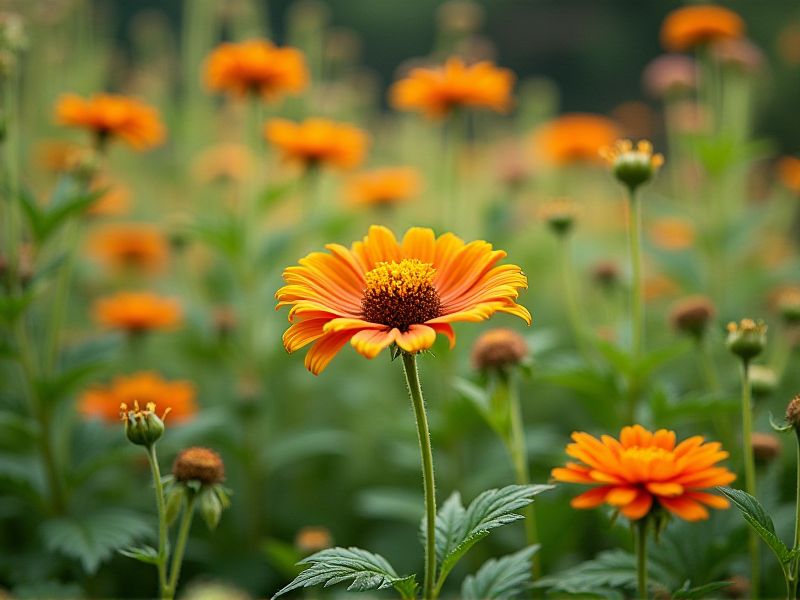
Self-seeding plants, such as California poppies, forget-me-nots, and larkspur, effectively fill garden gaps while requiring minimal maintenance. These plants thrive in diverse soil conditions and establish themselves effortlessly, ensuring vibrant color and life without the need for regular replanting. By allowing them to disperse their seeds naturally, you can create a dynamic garden that evolves each season. Moreover, self-seeding plants attract beneficial pollinators like bees and butterflies, enhancing biodiversity in your landscape. Incorporating these hardy varieties not only beautifies your space but also promotes ecological health.
List of some Self-seeding plants that fill garden gaps
- Foxglove (Digitalis purpurea)
- Columbine (Aquilegia vulgaris)
- Nasturtium (Tropaeolum majus)
- Forget-me-not (Myosotis sylvatica)
- Poppies (Papaver rhoeas)
- Borage (Borago officinalis)
- Feverfew (Tanacetum parthenium)
- Love-in-a-Mist (Nigella damascena)
- Cosmos (Cosmos bipinnatus)
- Calendula (Calendula officinalis)
Important things about Self-seeding plants that fill garden gaps
Natural Reseeding Process
Self-seeding plants are a valuable addition to gardens, as they naturally propagate and fill gaps without requiring much intervention from you. These resilient plants, such as calendula and poppies, thrive in various environments and adapt to soil conditions, making them ideal for low-maintenance gardening. By allowing certain plants to self-seed, you create a dynamic landscape that changes with the seasons, adding vibrant colors and textures each year. Tending to these self-seeders can enhance biodiversity, attracting beneficial insects and pollinators, while ensuring your garden remains lush and visually appealing.
Low Maintenance
Self-seeding plants, such as California poppy and cosmos, effortlessly fill gaps in your garden, bringing vibrant colors without much effort. These hardy varieties regenerate year after year, creating a naturalized look that enhances biodiversity. As they thrive in a variety of soil conditions, you can enjoy a flourishing garden without extensive maintenance or the need for constant replanting. Embracing these resilient plants not only saves you time but also contributes to a more sustainable gardening practice.
Diverse Plant Options
Self-seeding plants are an excellent choice for gardeners looking to effortlessly fill gaps in their landscape. These resilient plants, such as calendula, foxglove, and poppies, disperse their seeds naturally, leading to vibrant blooms year after year without the need for constant replanting. They not only enhance the aesthetic appeal of your garden but also support local ecosystems by attracting pollinators and beneficial insects. Incorporating self-seeding varieties allows you to create a dynamic, low-maintenance garden that evolves beautifully with the changing seasons.
Adaptability To Local Environment
Self-seeding plants are a remarkable addition to gardens, offering natural adaptability to local environments. By producing seeds that scatter and germinate, these plants can thrive in conditions unique to your garden's microclimate, improving biodiversity and soil health. Common examples include calendula, poppies, and foxgloves, which effortlessly fill gaps in your landscape while requiring minimal maintenance. Embracing self-seeding species not only enhances the aesthetic appeal of your garden but also promotes sustainability by supporting local pollinators and wildlife.
Soil Enrichment
Self-seeding plants are excellent choices for filling garden gaps while naturally enriching the soil. These plants, such as calendula, poppies, and alyssum, return each year by dropping seeds in your garden, creating a vibrant and evolving landscape. As they grow and die back, they contribute organic matter, enhancing soil structure and fertility. By incorporating self-seeding species into your garden, you can enjoy low-maintenance beauty while boosting the health of your soil.
Attracting Wildlife
Self-seeding plants such as cosmos, evening primrose, and calendula can effectively fill gaps in your garden while attracting diverse wildlife. By allowing these resilient flora to thrive, you create a vibrant ecosystem that invites beneficial pollinators like bees and butterflies. These plants not only add beauty but also serve as natural food sources and habitats for various insects and birds. Incorporating self-seeders into your garden design enhances biodiversity and fosters a sustainable environment, making your green space a haven for wildlife.
Seasonal Blooms And Colors
Self-seeding plants are an excellent solution for filling garden gaps, offering vibrant seasonal blooms without the need for constant replanting. These hardy plants, such as cosmos, calendula, and larkspur, thrive in various climates and produce abundant flowers that create a colorful tapestry throughout your garden. By allowing these species to self-seed, you not only enhance biodiversity but also enjoy the delightful surprise of new growth each year. Incorporating self-seeding plants into your landscape design can ensure a dynamic and flourishing garden that evolves naturally with the seasons.
Filling Empty Spaces
Self-seeding plants can be a gardener's best friend, effortlessly populating bare patches and bringing vibrant colors to your landscape. Popular choices include Daturas, Nigella, and California poppies, each known for their resilience and ability to thrive in diverse conditions. These plants not only enhance aesthetic appeal but also contribute to a balanced ecosystem by providing food and shelter for pollinators. By allowing self-seeding species to flourish, you can create a dynamic garden that evolves naturally with the seasons.
Potential For Invasiveness
Self-seeding plants can enhance garden aesthetics by spontaneously filling gaps, providing vibrant colors and unique textures. However, their potential for invasiveness necessitates careful consideration; some species may overwhelm native flora and disrupt local ecosystems. Monitoring growth and controlling spread is essential to prevent self-seeders from dominating and outcompeting more desirable plants. When planning your garden, research the specific self-seeding varieties to ensure they align with your gardening goals and ecological responsibilities.
Easy Propagation Techniques
Self-seeding plants, such as California poppies and foxgloves, effortlessly fill gaps in your garden while providing vibrant blooms year after year. These plants disperse their seeds naturally, allowing them to flourish in various conditions without the need for constant maintenance. By incorporating self-seeding varieties into your landscape, you can create a low-maintenance garden that adapts to seasonal changes and enhances biodiversity. To ensure a thriving ecosystem, simply allow some of the spent flowers to go to seed, and watch as nature fills your garden spaces with delightful surprises each spring.
